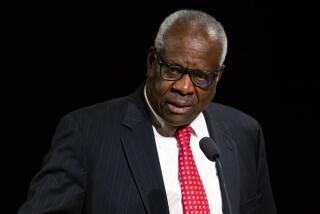Column: Peter Thiel, Gawker, and the risks of making the courthouse a private sandbox for the wealthy
Here’s the irony of Silicon Valley billionaire Peter Thiel’s role in bankrolling the legal campaign waged by wrestler Hulk Hogan against Gawker, the celebrity-trolling website: Thiel’s gripe about Gawker was that it invaded his privacy (by outing him as gay). But his actions against the website have made him more famous than he ever was before. And not entirely in a good way.
It’s a reminder to news organizations and civil libertarians how billionaires can help put sources of critical information out of business, if only for spite. One doesn’t even have to win a lawsuit, only sustain litigation long enough to wipe out one’s target financially. It also raises questions about who should have access to the courts, and for what ends.
And it points to an ever larger issue — the spreading business of litigation finance, in which investors put up money to support a lawsuit in exchange for a piece of any recovery.
Maintenance inspired by charity or benevolence (may be legal, but not) for spite or envy or the promise or hope of gain.
— Then-New York Judge Benjamin Cardozo, 1929
The former wrestling star’s lawsuit, which sought damages from Gawker’s publication of a sex tape, already has yielded a $140-million trial award in Hogan’s favor, large enough to jeopardize Gawker’s survival. A Florida judge last week denied Gawker’s appeal, but the website will appeal further.
Gawker founder Nick Denton and others long had speculated that a deep-pocketed source was secretly standing behind Hogan. Some of that speculation focused on Thiel, who co-founded PayPal and sits on the board of Facebook, in which he was an early investor. Thiel’s hostility for Gawker emerged after its now defunct website Valleywag supposedly outed him as gay in 2007. Though Thiel’s sexuality wasn’t a secret, he later called the site “the Silicon Valley equivalent of Al Qaeda.”
Thiel’s involvement in the Hogan case remained a secret until last week, when he owned up to backing Hogan with $10 million, calling it “one of my greater philanthropic things.” This was based, in part, on widespread distaste in his circle for Gawker, which on occasion has displayed a notable lack of respect for the rich and famous, and has been known to pick on innocent targets, too.
Yet even if one believes Gawker deserves its comeuppance in court, the most noxious aspect of Thiel’s activities shouldn’t be overlooked: he chose to hide behind Hulk Hogan instead of suing Gawker on his own behalf. That’s what sets Thiel apart from other plutocrats who have used their wealth to harass adversaries in court.
Donald Trump threatens to sue people all the time, but typically over supposed injuries to himself and always publicly (so far as we know). Idaho billionaire Frank VanderSloot pursued — on his own behalf – a three-year defamation lawsuit against the progressive magazine Mother Jones, which seriously damaged the publication’s financial position but was eventually dismissed. Thiel, as it happens, is slated to a Republican convention delegate for Trump, who has himself spoken in favor of loosening U.S. libel law so public figures like himself can do better in court.
Thiel’s support of Hogan’s case places him in the category of third-party litigant, whose interests generally have been frowned on by the courts because typically only those directly injured should have standing to sue. The exceptions generally involve cases where the injured parties can’t protect their own interests, or when plaintiffs can show a “close” relationship with the injured person. Neither exception would seem to apply here. If Thiel felt he had an actionable claim against Gawker, he could have filed suit. Instead, what he felt was anger and resentment, and he made Hulk Hogan his instrument of revenge.
Lawmakers and judges have wrestled for decades with the possible motivations of those who provide financial backing for others’ lawsuits. Supreme Court Justice Benjamin Cardozo, writing as a New York state judge in 1929, deemed that financial support “inspired by charity or benevolence” was acceptable, but not so “maintenance for spite or envy or the promise of hope of gain.”
Indeed, the latter practice long was held to be illegal, as the ancient common law crime of “champerty,” which amounted to buying an interest in the gains from a lawsuit. Eventually, however, legal prohibitions against champerty and related offenses fell away. That was largely because the development of professional ethics in the law was thought to have the same effect of discouraging frivolous lawsuits.
As litigation became more complex and costly, new methods were needed to cover the expense and keep the courthouse doors open to more than just the wealthy. Contingency fees, for example, arose as a way for lawyers to cover their clients’ expenses by granting the lawyers repayment out of any recovery.
In recent years, litigation finance has become institutionalized. Investment firms have sprung up with the explicit goal of investing in litigation for a share of the outcome. In January, the largest such firm, Chicago-based Gerchen Keller Capital, launched a $400-million fund aimed at institutional investors. The fund would bring Gerchen’s capital to $1.4 billion. Gerchen says it serves litigants as well as law firms by fronting “legal fee receivables and settlement payments.” (In other words, providing loans to be repaid from future fees and legal settlements.)
But the American Lawyer reported in December that growth in the field has outstripped the legal profession’s grasp of the ethical issues it raises. Big investors could influence case strategy or settlement negotiations to advance their own interests in conflict with those of the actual clients. Some have made alliances with particular law firms, which may or may not be the right firms for the job.
Some financing terms may be so onerous that the clients’ prospects of recovery even from a successful lawsuit may be much reduced. That could have occurred in a huge case pitting Ecuadorean peasants against the giant oil company Chevron, Fortune reported in 2011.
The plaintiffs’ case was backed by Burford Capital, a British litigation finance firm that in turn was backed by hedge funds and mutual funds in Britain and the U.S. Burford’s potential investment of $15 million would entitle it to up to 5.5% of any award.
The question Fortune raised was whether the group of largely illiterate Ecuadorean plaintiffs understood Burford’s arrangement. According to documents and testimony, the magazine said, Burford was entitled to a minimum of $55 million from a $1-billion plaintiffs’ recovery — 5.5%. But that $55 million was the minimum, even if the plaintiffs’ recovery was less than $1 billion. In the case of a $70-million recovery, in other words, Burford’s $55 million would amount to nearly 80% of the take. After other investors, attorneys and assorted other hangers-on got their cuts, the plaintiffs could be left with a handful of centavos. (The Ecuadorean court hit Chevron with a judgment of $18 billion in 2011, but that has been blocked by a U.S. court, which found that it was the product of fraud and racketeering by the plaintiffs’ lawyer.)
The problems of litigation finance are magnified when the identity of financial backers, along with their terms, often remain concealed. How then can anyone know what their motivations are?
There’s no point in seeking a solution from the American Bar Assn., which tackled the field of litigation finance in a 2012 white paper. The ABA paper explicitly disavowed any consideration of such “social policy” issues as “the desirability of this form of financing, or ... the systemic effects of litigation financing on settlements,” or its effect on “the incidence of litigation generally or unmeritorious (‘frivolous’) lawsuits specifically.” All that was left was the question of the duties of lawyers to their clients when someone else is footing the bill.
Thiel’s involvement in Hulk Hogan’s case raises many of these issues. Litigation can be so financially ruinous that a lawsuit funded out of “spite or envy” or even mere profit can effectively silence almost any individual or business that a wealthy investor finds annoying.
What’s the remedy? Attempting to ban any third-party financial support won’t work: That would only shut the courthouse door to low-income litigants and shift the balance of power to corporations or other defendants with the money to wait out their adversaries.
The identity of anyone and everyone with a financial investment or stake in the outcome of a lawsuit should be public. The motivations, investment terms and involvement in decision-making of anyone not a named party to a lawsuit are relevant considerations to a jury or judge.
Civil courts exist to enable those who have been injured to recover damages and those accused of injury to defend themselves. To allow anyone else to skulk in the wings, pursuing their own private goals in secret, is to turn the courts over to the rich, even more than they have been already. Few developments could be more frightening.
Keep up to date with Michael Hiltzik. Follow @hiltzikm on Twitter, see his Facebook page, or email [email protected].
Return to Michael Hiltzik’s blog.
UPDATES:
7:40 a.m., May 26: This post has been updated with Thiel’s admission of his role in backing Hogan’s lawsuit.
3:03 p.m., May 31: This post has been updated with recent developments.







